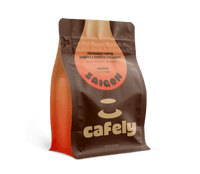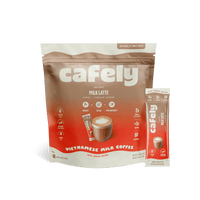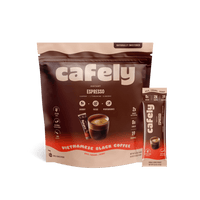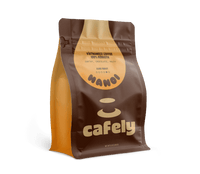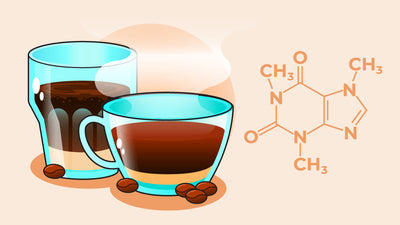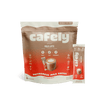Matcha, a Japanese green tea powder, generally contains around 19–44 mg of caffeine per gram.
The average serving size is 2 to 4 grams — meaning that each cup can have anywhere from 38 to 176 mg of caffeine.
This amount is much higher than regular green tea, which usually contains around 28 mg caffeine per cup [1].
A few different factors can affect the caffeine content of matcha, including:
- The type of leaves — Matcha is typically grown from specialty shade-grown tea plants, which maintain higher caffeine levels at harvest time than plants grown in full sun.
- How much powder is used — Typical doses are 2–4 grams, but some like their matcha even stronger.
- Freshness — Caffeine degrades over time, so the fresher the matcha powder is, the stronger the caffeine content.
- Brewing method — Some people filter their matcha to remove clumping, which will reduce the total caffeine content.
Caffeine Levels: Matcha vs. Tea vs. Coffee
Though they look and taste very different, matcha, green tea, and black tea all come from the same plant —Camellia sinensis [2]. However, due to key differences in processing methods, each type of tea contains different caffeine levels. Black tea is the most oxidized and usually has around 47 mg of caffeine per 8 oz cup. White tea is barely processed at all and yields about 55 mg of caffeine per 8 oz cup.
On the other hand, coffee is usually much higher in caffeine, sitting at around 95 mg for an 8-ounce cup of standard Arabica brew or 150 mg for a cup of robusta.
Depending on the amount of powder you use, matcha can contain more caffeine than an equal serving of coffee. Just 4 grams of matcha powder will provide approximately 176 mg of caffeine. Interestingly, caffeine in matcha is released into the body at a slower rate than coffee, leading to longer-lasting effects without the caffeine crash.
Related: Robusta vs. Arabica Coffee
Is Matcha Healthy?

When you drink matcha, you’re consuming the entire leaf instead of steeping the leaves in water. This makes matcha much higher in antioxidants than traditional green tea.
Studies have shown that matcha may lead to a variety of health benefits, including:
- Liver protection [3]
- Increased brain function [4]
- Anti-inflammatory properties [5]
- Lowered risk of heart disease [6]
- Positive effects on weight loss [7]
Additionally, matcha contains an amino acid called L-theanine, which has been shown to increase alpha waves in the brain [8] and has a stress-reducing effect on the body [9].
How Much Caffeine is Too Much?
According to the FDA, adults should consume no more than 400 milligrams of caffeine each day (equal to about 4-5 cups of matcha).
This amount of coffee is generally safe and doesn’t typically lead to dangerous or severe side effects. However, it’s important to keep in mind that everyone responds to caffeine differently, and some people may be more sensitive than others.
Too much caffeine in your body may cause negative side effects, such as increased heart rate, nervousness, insomnia, and headaches.
How to Brew Matcha for the Best Caffeine Extraction
Matcha’s caffeine levels depend on the amount of matcha powder used and the water temperature. More matcha means more caffeine, simple as that.
Use the following guidelines to measure the matcha, but feel free to tweak it to your liking:
- Standard consistency — one teaspoon.
- High caffeine and thicker consistency — 2-4 teaspoons.
- Less caffeine and thinner consistency — half a teaspoon.
Tools & Ingredients Needed
- Matcha whisk — Called a "Chasen," this small (usually bamboo) device is used to break up clumps of powder so they can dissolve in the water.
- Bowl — Any bowl will work, but a nice traditional matcha bowl adds an authentic touch to the experience.
- Measuring spoon — These are also usually made of bamboo, but you can use simple silverware.
- Matcha powder — For best results and stronger matcha, make sure to look for "ceremonial grade."
- Sifter (Optional) — This tool is optional but helps prevent clumps from entering your drink and makes whisking much easier.
- Hot water — Opt for water that’s hot, but not quite boiling for best results —around 195°F (90ºC) is ideal.
- Milk of choice (optional) — For some sweetness, consider adding some pre-heated milk or milk alternative to make a matcha latte.
Step-By-Step Instructions
- Measure Your Matcha Powder — Measure out your desired amount of powder and transfer it to the sifter.
- Sift Your Matcha Into a Bowl — Sift the powder into the bowl until it is smooth and there are no lumps. If you don’t have a sifter don’t worry, but you will need to spend extra time during the next step to avoid clumps.
- Add hot water and whisk — Add 2 ounces of hot water to the powder and whisk together until frothy. This can take about 30–60 seconds of aggressive whisking to achieve.
- Sweeten with Frothed Milk (Optional) — Once blended, you can either add more frothed milk or milk alternative to create a matcha latte. You can also sweeten it with a bit of honey or maple syrup.
What is the Best Time of Day to Drink Matcha?
While matcha may have a calming effect due to its L-theanine content, it is still quite high in caffeine.
For this reason it's best to drink matcha in the morning or early afternoon. With its slower release of caffeine compared to coffee, matcha can lead to lasting positive effects throughout the day without the jitters or caffeine crashes that are usually associated with coffee.
Avoid drinking matcha within 6 hours or so of your intended bedtime.
Related: How to Stay Awake Without Caffeine
FAQs: Caffeine in Matcha

Below are some frequently asked questions when it comes to matcha’s caffeine content.
1. How much caffeine is in a teaspoon of matcha?
One teaspoon of matcha usually has around 38–88 mg of caffeine, depending on the concentration. The quality of the matcha also affects the caffeine levels. Ceremonial-grade matcha will generally have more caffeine than culinary-grade.
2. Can matcha replace my morning coffee?
Yes! Matcha is a great alternative to coffee in the morning, particularly if you’re looking for a more gradual increase in energy without the caffeine crash or jitters. This is due to the caffeine being released into the body at a slower rate.
3. Is matcha better than coffee for avoiding jitters?
Yes. Due to the presence of L-theanine, matcha can increase alpha waves in the brain and produce a calming effect on the body. However, it still shouldn’t be consumed at night due to the high caffeine content.
4. How does the caffeine in matcha affect anxiety?
While still high in caffeine, matcha’s L-theanine content may help balance mood and produce a calming effect that may be a safer alternative for those with anxiety. First-time matcha drinkers may want to start with ½ teaspoon of matcha to see how their body responds.
5. What is the best way to measure matcha for consistent caffeine?
Using a digital scale is the most accurate way to measure matcha powder. To measure matcha powder, place the bowl on the scale and set the scale to zero. Then, slowly scoop the matcha into the bowl until you’ve reached your desired amount of matcha.
6. Does the quality of matcha affect its caffeine content?
Yes, higher-quality matcha often contains more caffeine. Ceremonial-grade matcha is of higher quality and typically contains more caffeine than culinary-grade matcha.
7. How long does caffeine from matcha last in the body?
Similar to coffee, the caffeine in matcha typically lasts for several hours. However, this can be influenced by personal metabolism. Tea and coffee comparison shows people drinking tea often experience a slower, more gradual increase in energy compared to coffee. Matcha usually doesn’t produce jitters or a caffeine crash like coffee often does.
8. Can I consume matcha in the evening?
While matcha does contain L-theanine, which can produce a calming effect, it's best to avoid drinking matcha close to bedtime due to its high caffeine content. It is recommended to drink matcha at least several hours before you plan on going to bed.
9. How does matcha caffeine compare to that in green tea?
Matcha typically has more caffeine than green tea due to how it is made. When you drink matcha, you are consuming the entire leaf. This leads to a higher caffeine content than green tea, which is simply hot water steeped with tea leaves.
10. Is there a decaffeinated matcha available?
No, unlike decaf coffee that's been stripped of its caffeine, all genuine forms of matcha contain some level of caffeine. To cut down on caffeine, try adding just ½ teaspoon of matcha powder to your drink.
References
- Kochman, J., Jakubczyk, K., Antoniewicz, J., Mruk, H., & Janda, K. (2020). Health benefits and chemical composition of matcha green tea: A review. Molecules, 26(1), 85.
- Zhao, T., Li, C., Wang, S., & Song, X. (2022). Green tea (Camellia sinensis): A review of its phytochemistry, pharmacology, and toxicology. Molecules, 27(12), 3909.
- Zhou, J., Yu, Y., Ding, L., Xu, P., & Wang, Y. (2021). Matcha green tea alleviates non-alcoholic fatty liver disease in high-fat diet-induced obese mice by regulating lipid metabolism and inflammatory responses. Nutrients, 13(6), 1950.
- Sakurai, K., Shen, C., Ezaki, Y., Inamura, N., Fukushima, Y., Masuoka, N., & Hisatsune, T. (2020). Effects of matcha green tea powder on cognitive functions of community-dwelling elderly individuals. Nutrients, 12(12), 3639.
- Sokary, S., Al-Asmakh, M., Zakaria, Z., & Bawadi, H. (2023). The therapeutic potential of matcha tea: A critical review on human and animal studies. Current Research in Food Science, 6, 100396.
- Anandh Babu, P. V., & Liu, D. (2008). Green tea catechins and cardiovascular health: an update. Current medicinal chemistry, 15(18), 1840-1850.
- Wang, Y., Yu, Y., Ding, L., Xu, P., & Zhou, J. (2022). Matcha green tea targets the gut–liver axis to alleviate obesity and metabolic disorders induced by a high-fat diet. Frontiers in Nutrition, 9, 931060.
- Williams, J., Kellett, J., Roach, P. D., McKune, A., Mellor, D., Thomas, J., & Naumovski, N. (2016). L-theanine as a functional food additive: Its role in disease prevention and health promotion. Beverages, 2(2), 13.
- Unno, K., Furushima, D., Hamamoto, S., Iguchi, K., Yamada, H., Morita, A., ... & Nakamura, Y. (2018). Stress-reducing function of matcha green tea in animal experiments and clinical trials. Nutrients, 10(10), 1468.
